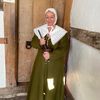
The health and safety of all our visitors, staff and volunteers is paramount, so we have hand sanitizers available for use around our sites; and we recommend the use of facemasks on the first and second floors of the museum, as well as the Merchant's House. Pre-booking is not required (except for schools and groups), but we will monitor the number of visitors across our sites.
If one of our buildings is particularly busy, we will ask you to begin your museum journey in one of the quieter sites first, before moving on to explore the others. We have also installed a new contactless payment system, so you can now pay with either cash or card. We have expanded our Natural History Collection, created new temporary displays and organised an exciting summer events programme.
If one of our buildings is particularly busy, we will ask you to begin your museum journey in one of the quieter sites first, before moving on to explore the others. We have also installed a new contactless payment system, so you can now pay with either cash or card. We have expanded our Natural History Collection, created new temporary displays and organised an exciting summer events programme.
Services
The John Moore Museum offers talks and tours relating to the museum and its collections, ideal for groups such as the WI, Probus, U3A, local history and civic groups. The talks help promote our museum and its collections. We charge a competitive rate with all money made going back into the museum. Our needs are simple!
Here at the John Moore Museum you can find answers to all of these questions and many more. The museum is made up of two buildings set into one of the finest rows of 15th century timber framed buildings in the country. The first building is home to an extensive Natural History collection featuring specimens of the mammals and birds native to our countryside, including farmlands, woodlands and wetlands.
This archive is a unique collection of recordings which document the lives of individuals who have lived in or been responsible for the upkeep of the Abbey Lawn Cottages over the past few decades. Recording began in 2010, as part of a project funded by the Heritage Lottery Fund to interpret the history of Number 45, better known as The Merchant's House.
Begin your visit to the museum by finding out more about the author and conservationist, John Moore, who is the inspiration behind our displays. Explore our extensive natural history collection to see for yourself why John Moore was so passionate about the countryside. Housed over three floors our collections include specimens of the mammals and birds native to our countryside, woodlands and wetlands.
A visit to the John Moore will tell you all kinds of interesting facts about the countryside and the animals that live in it. But here on our website you can see what's behind the displays and find out about the mini beasts that share our building! Because of its size, it is virtually impossible to take pictures of the layout in our smaller musuem.
Reviews (6)
Patrick Griffin
Oct 23, 2021
Report
Entered round the back of the building, this beautiful 15th century building is visited in two parts. The first building is dedicated to John Moore and his books. The town of Elmbury in his famous book is a thinly veiled reference to Tewkesbury. The museum is situated on three levels and has many exhibits of stuffed animals and old tools.
The second building, a few doors along, is a look at the life of a merchant who would have lived and worked in one of these houses. The house in question has been stripped back to what it would have looked like in the 15th century. Fascinating look at how the
The second building, a few doors along, is a look at the life of a merchant who would have lived and worked in one of these houses. The house in question has been stripped back to what it would have looked like in the 15th century. Fascinating look at how the
Tony A.
Jan 31, 2020
Report
Tim Bull
Jan 20, 2020
Report
Liz Ward
Sep 07, 2019
Report
Krys Bather
Oct 12, 2018
Report
Andrew Higdon
Jan 13, 2018
Report




